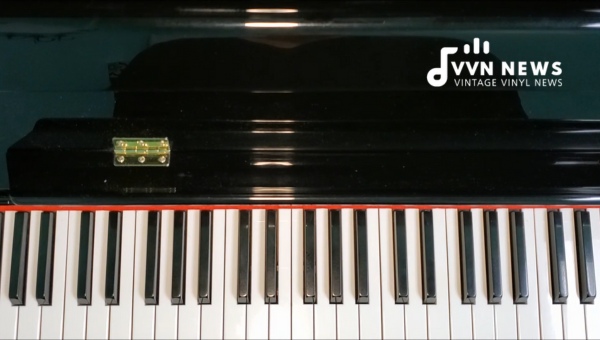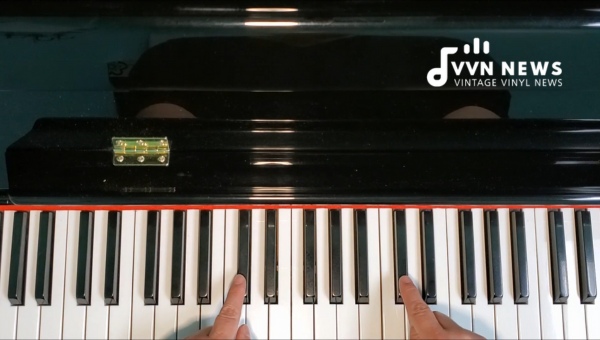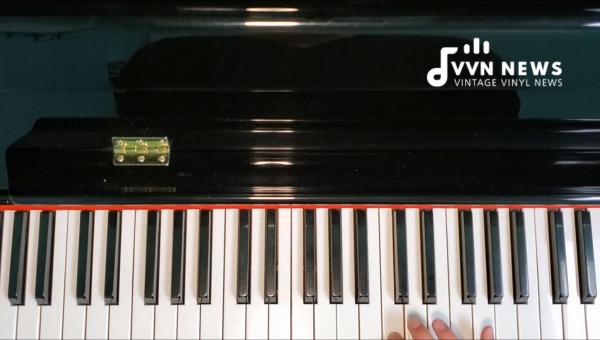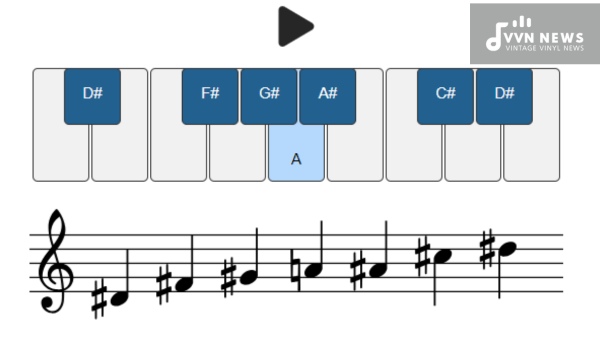If you’ve ever felt the emotional pull of a heartfelt blues solo or been captivated by the gritty riffs of a rock anthem, there’s a good chance that what moved you was the raw, expressive power of the blues scale.
In particular, the D sharp minor blues scale is a treasure trove for guitarists and musicians looking to add depth and soul to their playing.
With its unique combination of notes, this scale can transport your music to new heights, evoking feelings that resonate with listeners on a profound level.
The nuances and characteristics of the D sharp minor blues scale can open up a world of creative possibilities for your musical expression.
It presents an interesting blend of tonal colors that set it apart from more conventional scales, making it an essential tool in any improviser’s arsenal.
Whether you’re just starting out or you are an experienced player wanting to refine your use of this captivating scale, I’m here to guide you through its structure and application so that you can harness its emotive potential in your own playing.
Structure of the D Sharp Minor Blues Scale
The D sharp minor blues scale is intrigue and depth encapsulated in six notes.
The formula consists of the root (D#), a minor third (F#), a perfect fourth (G#), an augmented fourth or diminished fifth (A), a perfect fifth (A#), and a minor seventh (C#). This blend creates an enigmatic sound pattern:
- Root: D#
- Minor third: F#
- Perfect fourth: G#
- Augmented fourth (or diminished fifth): A
- Perfect fifth: A#
- Minor seventh: C#
Each interval contributes to the scale’s haunting personality, pivotal for blues, jazz, and rock genres, empowering solos with heart-wrenching gravitas.
Also Read: Lydian Mode [Brighten Your Melodies With This Unique Scale]
Guide to Assembling the D Sharp Major Blues Scale

Creating the D sharp major blues scale is a journey into the fusion of soulful sounds and technical precision.
Let’s dive into the steps that will enable you to master this scale:
Step 1: Identify The Root Note
Your starting point is the root note, D sharp (D#). It is the foundation upon which the entire scale is built.
Step 2: Scale Formula
Remember, a major blues scale is based on a pentatonic framework with an additional “blue” note. For D#, follow this sequence:
- Whole Step
- Half Step
- Half Step (also referred to as a “blue” note)
- Half Step
- Whole step and a Half
- Whole Step
Step 3: Note Composition
The notes in your D sharp major blues scale will be:
- D# – Root
- F# – Major second
- G# – Major third
- A – Perfect fourth (the “blue” note)
- A# – Perfect fifth
- C# – Major sixth
Commit these notes to memory as they are pivotal for constructing melodies and improvisations.
Also Read: G Major Scales And Chords [Expand Your Musical Understandings]
Step 4: Apply To Your Instrument
Familiarize yourself with finger placements and voicings specific to your instrument, whether it’s a guitar fretboard or piano keys.
By following these steps diligently, you’ll craft musical phrases that resonate deeply with the emotive essence of blues, all from harnessing the power of the enigmatic D sharp major blues scale.
Different Shapes for D Sharp Minor Blues Scale
As a musician, exploring various shapes and positions on the fretboard for the D sharp minor blues scale can significantly expand your improvisational skills and give you a fluid mastery over your instrument.
Here are five distinct shapes that will allow you to navigate this emotionally rich scale across the entire neck of the guitar.
Shape 1: The Root Position
In this primary shape, we start with our index finger on the sixth string, eleventh fret, which is D#.
Using a combination of whole steps and half steps with some added blues notes, you’ll move through this shape like so:
- Index finger: 11th fret (D#)
- Ring finger: 13th fret (F#)
- Pinky: 14th fret (G)
- Index finger moves to fifth string: 11th fret (A#)
Shape 2: The Classic Box
Transitioning to Shape 2, emphasizes bending techniques. It begins on the fourth string:
- Index finger: 11th fret (D#)
- Ring finger bends at the 13th fret (F#) up a half step
Shape 3: Up the Neck
Shifting upwards, Shape 3 utilizes legato playing and slides. Start on:
- Pinky on third string: 16th fret (C#)
- Slide up to first string using index and ring fingers between the 14th and 17th frets
Shape 4: The Upper Octave Extension
Extend your reach with octave jumps. In Shape 4:
- Use pinky or ring finger on second string,17th fret then jump back to
- Index on third string,13th fret
Shape 5: Horizontal Exploration
Explore horizontally along a single string with “Shape 5.” You create melodies by sliding or bending along just one string:
Creating Melodic Lines:
- Choosing second string,
- Begin bend at index finger’s position at the eleventh fret,
- Work way up incrementally toward higher notes.
Each of these five shapes offers different nuances and textures when playing the D sharp minor blues scale.
Also Read: E Major: Scale And Chords [Exciting Sounds For Your Compositions]
The Distinctive Qualities of D Sharp Major and Minor Blues Scales

When delving into the world of blues scales, appreciating the distinctions between major and minor variants is crucial.
Both scales provide a distinct mood and color to music, transforming a piece significantly depending on which is employed.
Let’s explore the differences between the D sharp major and minor blues scales.
D Sharp Minor Blues Scale:
The D sharp minor blues scale is an intriguing musical tool that jazz and blues musicians often employ to create a more somber, soulful vibe. This scale is constructed from the following notes:
- D#
- F#
- G#
- A
- A#
- C#
When you play these notes in sequence, you’ll notice the depth and the poignant sound they produce, which is characteristic of melancholic melodies or tense musical passages in blues and jazz.
D Sharp Major Blues Scale:
In contrast, the D sharp major blues scale has a slightly brighter and more uplifting feel.
It’s derived from combining the typical major scale with an additional “blue” note. These notes include:
- D#
- F
- G
- G# (the “blue” note)
- A#
- C
Here, the extra blue note stands out as it introduces a bit of tension against the generally happy-sounding major backdrop.
The Contrast:
When comparing these two scales side-by-side, their differences become apparent not only on an emotional level but also harmonically.
The minor blues scale leans into that darker quality due to its use of the minor third (F#) and minor seventh (C#), while the major blues scale features a major third (F) that distinctly brightens its tonal quality.
Whereas C# provides closure in the minor variant with a definitive return to root feeling; in contrast, C teases slightly before resolving comfortably back to D# in its major counterpart.
Musicians leverage these subtle but impactful variations between D sharp major and minor blues scales to convey different moods, ensuring that their compositions or improvisations connect with listeners more effectively.
Also Read: B Major: The Scale And Chords [Guide To This Bold & Beautiful Key]
Effective Tracks for D Sharp Minor Blues Scale
While the D sharp minor blues scale may not be as commonly referenced as its counterparts in E or A, it nonetheless holds a distinguished place in music, particularly in genres that thrive on emotional depth and complexity.
For guitarists and other musicians seeking inspiration or looking to dissect the scale’s use in practice, select tracks stand out as quintessential studies.
These pieces showcase the expressive versatility of the D sharp minor blues scale:
- “Still Got the Blues” by Gary Moore – Known for its haunting melody, this song’s solo sections are rooted in a minor blues scale, often transcribed into E flat (D sharp) for convenience. Moore’s phrasing demonstrates how the scale can be used to build tension and release, creating an immersive listening experience.
- “Since I’ve Been Loving You” by Led Zeppelin – The weeping guitar work by Jimmy Page exemplifies the emotive power of bending and vibrato within the D sharp minor blues context. The lead lines flirt with elements of both major and minor tonalities offered by this versatile scale.
- “Parisienne Walkways” also by Gary Moore – Yet another testament to Moore’s prowess with the blues, this track stands as a melodically rich example of how well the D sharp minor blues scale can convey longing and nostalgia.
Embarking on these tracks will not only provide you with practical application but also inspire original improvisations and compositions within your own musical journey.
Why Prioritize Ear Training for the D Sharp Minor Blues Scale?

Ear training is a critical component of mastering any musical scale, and the D sharp minor blues scale is no exception.
Here’s why it should take precedence in your practice routine:
- Develops Intuition: Learning to recognize the distinctive intervals and nuances of the D sharp minor blues scale by ear will allow you to more naturally integrate it into your playing.
- Improves Improvisation: When you can identify the scale’s sound without hesitation, your improvisational skills will flourish. A trained ear helps you predict which note comes next, vital when jamming or soloing.
- Enhances Expressiveness: The blues is all about expression. By internalizing the sound of each note in the scale, you’ll be able to convey emotions more effectively and dynamically through your instrument.
- Facilitates Transcription: Musicians often learn from their idols by listening. With a well-trained ear, you’ll be able to transcribe riffs and licks in D sharp minor with greater accuracy, broadening your blues vocabulary.
- Aids in Composition: Composing music becomes much easier when you can hear melodies and harmonies in your head. Ear training with this scale helps you put those ideas down on paper more efficiently.
In essence, prioritizing ear training for the D sharp minor blues scale allows for a deeper connection between your music and your audience.
Harnessing this sonic palette fully empowers you not only as a performer but also as a creative artist keen on leaving an indelible mark on listeners’ hearts.
Also Read: A Sharp Minor Pentatonic Scale [Unique Harmonic Possibilities]
FAQs About the D Sharp Minor Blues Scale
What notes are in the D Sharp Minor Blues Scale?
The notes in the D Sharp Minor Blues Scale include D#, F#, G#, A, A#, and C#.
How does the D Sharp Minor Blues Scale differ from the Major Blues Scale?
The D Sharp Minor Blues scale consists of a minor third, whereas the Major Blues Scale incorporates a major third.
Can I use the D Sharp Minor Blues Scale over any chord progression?
The scale is most effective over minor key progressions or where chromatic expression is desirable.
Are there any well-known songs that feature the D# Minor Blues Scale?
Yes, many blues and rock songs feature this scale; “The Thrill is Gone” by B.B. King is a prime example.
Is it better to learn the scale patterns or focus on ear training first?
It’s essential to do both; learn scale patterns for muscle memory and ear training for improvisational skills.
Conclusion
In wrapping up, mastering the D sharp minor blues scale can be a game-changer for your musical expression.
It’s all about getting comfortable with the scale’s moody, soul-stirring tones and experimenting with its flexible structure to create sounds that truly resonate.
By internalizing the distinctive intervals and practicing across various contexts, you’ll unlock new avenues for improvisation and storytelling through your instrument.
Lean into this journey of exploration, and you’ll find that the D sharp minor blues scale can be a powerful ally in your musical toolkit.








